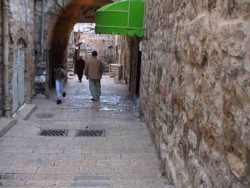Domari (Dom, Domani, Domi, Qurbati)
Domari :: Language-genetic affiliation
Domari is an archaic Indo-Aryan language. Its origin is in the so-called Central Indo-Aryan languages, from which languages such as Hindi, Rajasthani and Gujarati also descend. This is confirmed both by its lexical profile and especially by a layer of phonological developments that took place in the transition period from Old to Middle Indo-Aryan, during the first half of the first millennium, and are specific to the Central group. A number of features testify to a split from the languages of India in the medieval period. Domari shows a number of innovations that are typical of the early New Indo-Aryan period, but also a number of remarkable archaisms, especially the retention of the present-tense verb conjugation. Some innovations are shared specifically with the group of so-called Northwesten Indo-Aryan frontier languages, such as Kashmiri, and point to a period of settlement in this region after moving away from the central regions. This overall profile of development is shared with Romani, though despite remarkable similarities the two languages also differ in several fundamental traits, not least in some basic vocabulary and grammatical vocabulary items, which makes it unlikely that they split from the same medieval ancestor language.
Domari :: Historical distribution Map
Domari is one of several Indo-Aryan languages that are spoken outside of India by populations who historically specialised in itinerant trades and services. The others include Romani in Europe, Parya and Jat in the Middle East and Central Asia, and the vocabulary used by the Lom of the Caucasus. The Dom appear to have been settled in the Kurdish regions for a prolonged period. Their spread throughout the Middle East will have followed the conquests of Saladin in the twelfth century, and perhaps only took place during the Ottoman period. From fragmented documentation of Domari wordlists and phrases from the early nineteenth century the presence of dispersed Dom communities is attested as far north as Azerbaijan, to as far south as northern Sudan, and from Diyarbakir in eastern Anatolia to the vicinity of Baghdad.

Domari :: Present-day distribution and endangerment Map
Domari speaking communities are known to exist today in the region of Diyarbakir in eastern Turkey, in the Beqaa valley of Lebanon, in and around Damascus (Syria) and Amman (Jordan) as well as in the Iraqi-Jordanian border area and the Jordan valley, in the Old City of Jerusalem and refugees camps in the West Bank and Gaza (Palestine), and in the Egyptian town of El-Arish in Sinai. Knowledge of Domari has declined among the Dom following significant changes in their economic and social organisation during the past few generations. Until the 1950s most Dom were still engaged in metalwork and in entertainment, and were semi-nomadic. Traditional trades and the nomadic lifestyle have since been abandoned in many communities. In Jerusalem, the Dom abandoned tents and metalwork in favour of rented accommodation and wage labour already in the 1940s. The young generation grew up with no ties at all to the traditional lifestyle, while by contrast free and compulsory education has increased the pressure to adopt Arabic as an everyday language. It is known that at least in Damascus, Amman, Gaza, El-Arish and Jerusalem, knowledge of the language is limited to the elderly members of the community and is not being passed on to the younger generations, who have shifted completely to Arabic. The situation in other communities is not clear, but it seems that at least some varieties of Domari are highly endangered. Domari has always been an oral language, with no written form and no documentation.
Domari :: General structural characteristics
Like other Indo-Aryan languages, Domari is an inflectional language. Some of its inflection is comparatively recent and shows strong agglutination, while in other domains Domari is one of the most archaic Indo-Aryan languages, preserving the Old Indo-Aryan present tense person conjugation and passive inflection. As a result of contact, Domari syntax is strongly modelled on that of Arabic, showing for example VO word order. Domari grammar in the only investigated variety, that of Jerusalem, is massively influenced by Arabic and shows numerous categories of almost wholesale borrowing from Arabic, such as conjunctions, prepositions, numerals, aspect and modality auxiliaries, and more. The vocabulary shows, in addition to Arabic, numerous words of Kurdish and Turkish origin. Domari adopts Arabic phonemes with Arabic words, and some of those also spread to the inherited vocabulary. Among the few phonemes that Domari possess and which are not shared with Arabic are the open back vowel /å/ and the voiceless labial stop /p/.
Domari :: References to Yaron Matras's work
- 2007. Grammatical borrowing in Domari. In: Matras, Y. & Sakel, J. eds. Grammatical borrowing in cross-linguistic perspective. Berlin: Mouton. 151-164
- 2005. The full extent of fusion: A test case for connectivity and language contact. In: Walter Bisang, Thomas Bierschenk, Detlev Kreikenbom und Ursula Verhoeven. (eds.) Kulturelle und sprachliche Kontakte: Prozesse des Wandels in historischen Spannungsfeldern Nordostafrikas/Westasiens. Akten zum 2. Symposium des SFB 295. Würzburg: Ergon Verlag. 241-255.
- 2005. Language contact, language endangerment, and the role of the 'salvation linguist' In: Austin, Peter K. ed. Language documentation and description, Volume 3. London: Hans Rausing Endangered Languages Project. 225-251.
- 2000. Two Domari legends about the origin of the Doms. Romani Studies, 5th series, 10, 53-79.
- 1999. The state of present-day Domari in Jerusalem. Mediterranean Language Review 11, 1-58.
Domari :: Links to other websites
- Manchester Romani Linguistics - Research Projects - Domari
- Language Contact Manchester Yaron Matras' case study on Domari
- Kuri - Journal of the Dom Research Center